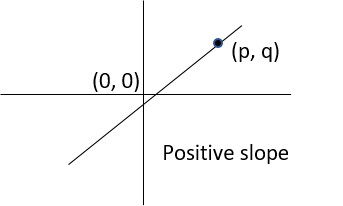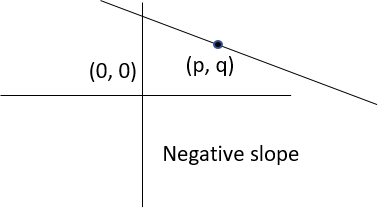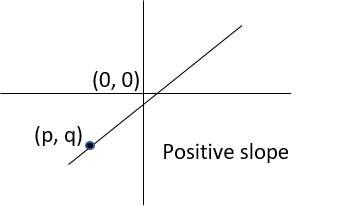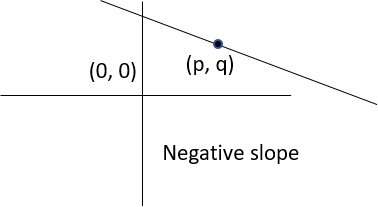GMAT Questions | Coordinate Geometry Q5
Lines with positive slope, intercepts, quadrants | Data Sufficiency
This GMAT data sufficiency (DS) question is from the topic Coordinate Geometry. A medium level difficulty question testing concepts about positive sloping lines, intercepts of such lines and the quadrants through which the line passes. An interesting GMAT 650 to 700 level Co geo data sufficiency question.
GMAT Data Sufficiency | Directions | Click Here ▼
This data sufficiency problem consists of a question and two statements, labeled (1) and (2), in which certain data are given. You have to decide whether the data given in the statements are sufficient for answering the question. Using the data given in the statements, plus your knowledge of mathematics and everyday facts (such as the number of days in a leap year or the meaning of the word counterclockwise), you must indicate whether -
- Statement (1) ALONE is sufficient, but statement (2) alone is not sufficient to answer the question asked.
- Statement (2) ALONE is sufficient, but statement (1) alone is not sufficient to answer the question asked.
- BOTH statements (1) and (2) TOGETHER are sufficient to answer the question asked, but NEITHER statement ALONE is sufficient to answer the question asked.
- EACH statement ALONE is sufficient to answer the question asked.
- Statements (1) and (2) TOGETHER are NOT sufficient to answer the question asked, and additional data specific to the problem are needed.
Numbers
All numbers used are real numbers.
Figures
A figure accompanying a data sufficiency question will conform to the information given in the question but will not necessarily conform to the additional information given in statements (1) and (2)
Lines shown as straight can be assumed to be straight and lines that appear jagged can also be assumed to be straight
You may assume that the positions of points, angles, regions, etc. exist in the order shown and that angle measures are greater than zero.
All figures lie in a plane unless otherwise indicated.
Note
In data sufficiency problems that ask for the value of a quantity, the data given in the statement are sufficient only when it is possible to determine exactly one numerical value for the quantity.
Question 5: Is the slope of the line that passes through the point (p, q) positive?
Statement 1: p, q > 0
Statement 2: The x-intercept of the line is k, such that k > p.
Get to 705+ in the GMAT
Online GMAT Course
@ INR 10,000 + GST
Video Explanation
GMAT Live Online Classes
Starts Sat, Jan 24, 2026
Explanatory Answer | GMAT Coordinate Geometry DS
Step 1: Decode the Question Stem
Q1. What kind of an answer will the question fetch?
The question is an "Is" question. Answer to an "is" questions is either YES or NO.
Q2. When is the data sufficient?
If we get a conclusive yes, the data is sufficient. The data is sufficient even if we get a conclusive no. The data is not sufficient only when we do not get a conclusive answer.
Q3. When is the answer YES and when is it NO?
If we can determine that the slope of the line is positive, the answer is yes.
Conversely, if we can determine that the slope is either negative or is 0, the answer is no.
Step 2: Evaluate Statement 1 ALONE
Statement 1: p, q > 0
From this information, we know that the point (p, q) is a point in the first quadrant. Both positive and negative sloping lines pass through the first quadrant as shown below.


We are NOT able to find a DEFINITE answer to the question using Statement 1.
Hence, statement 1 alone is NOT sufficient.
Eliminate answer options A and D.
Step 3: Evaluate Statement 2 ALONE
Statement 2: The x-intercept of the line is k, such that k > p.
We do not know anything about p. So, the line could either be positive sloping or negative sloping depending on what value p takes.
Approach: Look for a counter example
Example: The point (p, q) is a third quadrant point. The x intercept of the line is greater than p. The line has a positive slope.

Counter Example: The point (p, q) is a first quadrant point. The x intercept of the line is greater than p. The line has a negative slope.

We are unable to answer the question with a DEFNITE YES/NO using Statement 2.
Hence, statement 2 alone is NOT sufficient.
Eliminate answer option B.
Step 4: Evaluate Statements TOGETHER
Statement 1: p, q > 0
Statement 2: The x-intercept of the line is k, such that k > p.
A line with a positive slope will have both its x and y coordinates increasing simultaneously.
The y coordinate of the x-intercept of the line is 0. The y coordinate of any point (p, q) in the first quadrant will be positive. So, q > 0.
For positive sloping lines, because x and y coordinates must increase in tandem, if point (p, q) is in the first quadrant its x coordinate will be greater than the x – intercept. So, p > k.
From statement 2, we know that p < k. So, the line CANNOT be positive sloping.
We are able to find a conclusive answer to the question.
Hence, statements TOGETHER are SUFFICIENT.
Eliminate answer option E.
Choice C is the correct answer.
GMAT Coordinate Geometry Videos On YouTube
GMAT Sample Questions | Topicwise GMAT Questions
Copyrights © 2016 - 26 All Rights Reserved by Wizako.com - An Ascent Education Initiative.
Privacy Policy | Terms & Conditions
GMAT® is a registered trademark of the Graduate Management Admission Council (GMAC). This website is not endorsed or approved by GMAC.
GRE® is a registered trademarks of Educational Testing Service (ETS). This website is not endorsed or approved by ETS.
SAT® is a registered trademark of the College Board, which was not involved in the production of, and does not endorse this product.
How to reach Wizako?
Mobile: (91) 95000 48484
WhatsApp: WhatsApp Now
Email: [email protected]
Leave A Message

